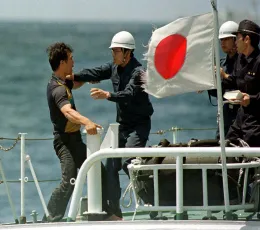Educator Overview
Case Overview
Set in September 2016. Japan has long maintained an Air Defense Identification Zone (ADIZ) that encompasses the Senkaku/Diaoyu Islands, over which it has administrative control. China declared its own ADIZ in 2013, stating it had the right to take military action against any aircraft that entered the zone without prior notification. Japan, along with the United States and South Korea, has protested the Chinese ADIZ and refuses to conform to China’s demand for prior notification. Japanese civilian and military aircraft continue to operate in the skies above the East China Sea. The intensification of the island dispute has raised political sensitivities in both countries, making it difficult for leaders to ignore the increasing interaction between ships and aircraft in the area. China now sends its coast guard to patrol the islands alongside Japan’s coast guard. The changing balance of military and economic power in Asia, growing popular distrust between the two nations, and deep dependence on the sea lanes for access to energy resources and trade have heightened concerns that Japan and China may inadvertently end up in an armed clash. Miscalculation by their militaries or an unforeseen incident provoked by fishermen or sovereignty activists could trigger a crisis. Washington does not take a position on the disputed sovereignty claims, but the United States has a treaty commitment to defend Japanese territory, including territory under its administrative control, against attack or the threat of attack. Because the use of force between China and Japan would likely lead to U.S. involvement, Washington has a stake in deterring and dissuading aggression by either party. The U.S. government has decided to convene a National Security Council (NSC) meeting to consider any action it should take to ease tensions in the East China Sea and to evaluate its long-term policy in the region.
Decision Point
Over the Summer of 2016, tensions in the East China Sea suddenly ratcheted up. In June, a Chinese frigate sailed through the disputed zone of the East China Sea. Although Chinese coast guard ships passed through the area before, this marked the first appearance of a Chinese naval vessel. In the following weeks, China alleged that Japanese fighters intercepted its military aircraft over the disputed islands. During the incident, Japan’s fighters briefly locked weapons radar on the Chinese aircraft. Two months later, hundreds of Chinese fishing vessels appeared in the waters near the disputed islands in the East China Sea. For the first time, these vessels were accompanied by seven Chinese law enforcement vessels.
With tensions showing no sign of easing, policymakers and media outlets alike have turned their eyes to Washington to see how the United States will respond. The president has convened a National Security Council meeting to consider possible action it could take to ease related tensions.
Learning Goals
CFR Education simulations use a variety of pedagogical tools to create an effective, meaningful, and memorable learning experience for students that builds their global literacy. Students will develop crucial skills such as critical thinking, communication, collaboration, and creativity. Students will complete authentic assessments that feel relevant: instead of five-paragraph essays and book reports, students will write policy memos and participate in a role-play of a meeting of a foreign policy–making body. There are no right or wrong answers in actual policy deliberations, and there are none here, either; students will walk away from this experience with an appreciation for the complexity of policy questions.
In this simulation, students will learn about the National Security Council, as well as meeting these learning outcomes specific to this simulation:
- Students will understand the multifaceted nature of U.S. interests in the East China Sea dispute between China and Japan.
- Students will consider how a miscalculation or use of force between China and Japan would destabilize the region and disrupt the global economy.
- Students will evaluate the various options that the United States has to help resolve the dispute in the East China Sea.
Concepts and Issues
Concepts
- Great power rivalry
- Preventative measures
- Dispute resolution
- Sovereignty
- Nationalism
- Alliances
Issues
- U.S. treaty responsibility to Japan
- Relations between established and rising powers in Asia
- Trade and investment relationships among China, Japan, and the United States
- Balance of power in the Pacific
